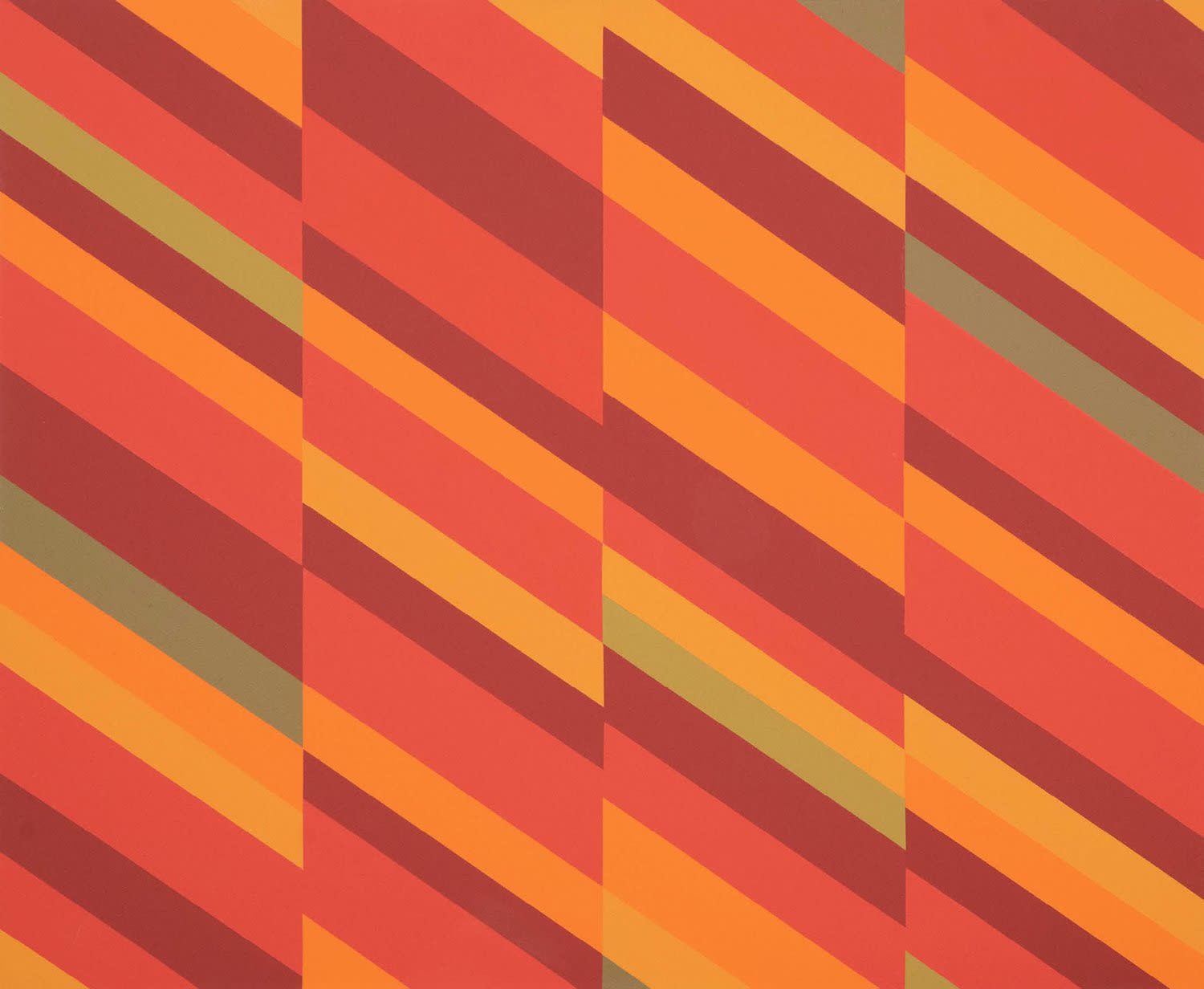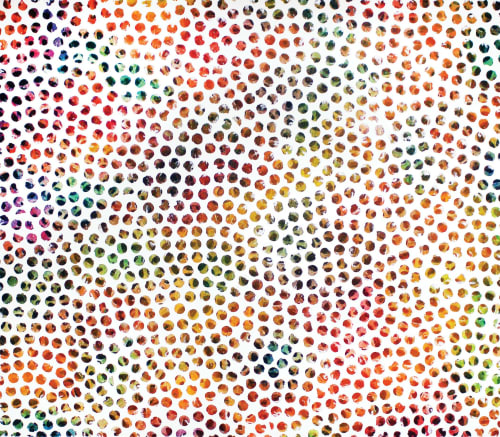
As part of the Sweet Sixteen exhibit on display at the Dixon, this artist’s canvases seem almost to vibrate.
Human nature dictates that we look for patterns in the world around us, like seeing a face in the grain of wood or a piece of toast. It’s a need to find order and meaning among random phenomena, to have a sense of control, especially when your reality offers little room for self-determination. For James Little, who grew up in a segregated Memphis, this desire to create meaning, rather than have meaning imposed upon him, drove him to the abstract paintings he’s created for most of his career.
 Little, born in 1952, began drawing at a young age — “at 3, 4 years old,” he says. He would copy comic strips and reproductions of paintings from library books. When he was 8, his mother bought him his first paint set. “I was like any other kid. I did all the other stuff,” he recalls. “I played basketball, climbed trees, played in the streets. I always had a curiosity about art and collectibles and archaeology. I always had an imagination. I wanted to try and figure out what was going on. I was inquisitive, nosey. … So that all contributed to me pursuing a career in the arts. It’s something that I have a lot of passion for.”
Little, born in 1952, began drawing at a young age — “at 3, 4 years old,” he says. He would copy comic strips and reproductions of paintings from library books. When he was 8, his mother bought him his first paint set. “I was like any other kid. I did all the other stuff,” he recalls. “I played basketball, climbed trees, played in the streets. I always had a curiosity about art and collectibles and archaeology. I always had an imagination. I wanted to try and figure out what was going on. I was inquisitive, nosey. … So that all contributed to me pursuing a career in the arts. It’s something that I have a lot of passion for.”
Little attributes this passion-driven work ethic and dedication to his parents. His father worked in construction, and his mother was a cook. “I would go with my father to construction sites. We used to mix mortar and cement. So I kind of got a feel for making stuff and mixing stuff and hard work, rigorous kind of work,” he says. “[My mother] used to come up with these different recipes and these different ways of making cakes and pies and cooking stuff and making it better and better and that kind of thing — and having fun doing it.”
In the 1970s, Little enrolled in the Memphis Academy of Art (later named Memphis College of Art, and now sadly defunct). “I have to say that [my parents] encouraged me, which was a rare kind of thing,” he says. “Even when I went to the art academy, [the teachers] tried to push us toward more practical professions because the whole thing was, ‘You’re not going to make a living with this painting thing. We teach this, but you’ve got to have something where you can make some money.’ They tried to push us toward advertising and a lot of Black kids at the school, and white kids, too, were pushed to advertising.
“I took a year in that, or a semester — I don’t know — but I couldn’t take it. It just wasn’t for me. Painting was it. It kept tugging at me and that was it. It’s a risky, courageous thing to do, to go after this thing.”
A formal education in the arts, he says, passes on ideas and skills that have been developed for millennia, skills that an artist might not learn outside of an institutionalized climate. Such an education elevates the artist and their art, providing them with the knowledge of how to balance form, color, line, shape, and texture — skills Little has mastered and reinterpreted into his work.
That’s when he turned to the abstract, an art form that demands risk. “I guess it came from seeing other kinds of art and then you just try to figure out where your heart is and where your imagination is and where your skill set is,” he says. “I was a person that said there’s no reason for me to paint a figure, to keep doing a figure. Why should I keep doing that? It’s not that I have anything against the figure, but I don’t have anything for it. So I wanted to experiment, and in modern art and abstraction, experimentation was allowed. It was liberating.”
While in Memphis, though, Little says his exposure to the arts remained limited. The collection at Brooks Museum of Art, a minute’s walk from the academy, was not as extensive and diverse as it is today. “To put it lightly, it was a segregated place,” he says. So instead, he often turned to those reproductions he saw in library books to study the evolution of art and the diversity within it. “We used to take a trip to the Art Institute of Chicago. Going to stuff like that opened my eyes.”

James Little, Rosa’s Mantra, 2018. Raw pigment on canvas. Courtesy of the artist
The academy also invited visiting artists and offered a rigorous curriculum, of which Little speaks highly, noting his disappointment about the school’s closure in 2020. A formal education in the arts, he says, passes on ideas and skills that have been developed for millennia, skills that an artist might not learn outside of an institutionalized climate. Such an education elevates the artist and their art, providing them with the knowledge of how to balance form, color, line, shape, and texture — skills Little has mastered and reinterpreted into his work. “You can’t do that stuff independently,” he says. “I think [the school’s closure] is a terrible thing to happen to a city, and they should reopen it. They need to reopen that school.”
After all, while at the Memphis Academy of Art, Little began showing his work around Memphis and Arkansas. “We were trying to make something happen,” he says. “I had begun to get a lot of buzz in Memphis and Arkansas.” He was eventually scouted by Syracuse University, which awarded him a fellowship so he could earn his MFA.
When it comes to laying down the patterns of dots or lines that make up his work, Little says, “There’s no narrative. It’s based on imagination. … I’m not a linear thinker. The orbit that I’m in is more of an intuitive decision-making space.”
While his schooling in New York was paid for, Little had to pay for his travels. “My mother and the church raised money,” he says. “Jameson Jones [the academy’s director at the time] loaned me some money to get there. Everybody was behind me, and when you do this kind of thing, if you fail, you let all these people down, the city, the church, the school.”
This wasn’t the only pressure resting on Little’s shoulders. He adds, “I have to say that a lot of the stuff that happened — us getting into these schools — a lot of it happened right after the assassination of Martin Luther King. It has to be recognized that these schools were not these little old bastions with open arms. Because Memphis was a segregated place. So after Dr. King was killed, everybody was trying to pack us into these schools everywhere — in Memphis, Syracuse, New Haven, all of them. A lot of people got into these places based on the blood of Dr. King and the blood of a lot of other people.”

James Little, Grey Noise, 2019. Raw pigment on canvas. Courtesy of the artist
This awareness of those who created a more hopeful world for Little — one in which he could succeed as an artist — has woven its way through his works, within which Little hopes to convey a sense of optimism. “What I mean by optimism,” he says, “I mean [observers] being able to engage with [the work], to have pleasure” — to appreciate the labor put forth by the artist and, perhaps, the labors put forth by others for the artist’s sake.
As such, Little approaches each piece with patience, beginning with making his own paints by mixing pigment with wax — a process dating back to ancient Egypt. “The stuff that I do, it’s really hard to develop some kind of recipe for,” he says. “I know what the core materials are, but if I want to change the effect or the look or the design, sometimes I can change the medium for that particular thing. If I use varnish, sometimes I thin it down for certain works, sometimes I make it thicker. … I pretty much decide on what I want to do and where I want to go based on the material I decide to work with.”
When it comes to laying down the patterns of dots or lines that make up his work, Little says, “There’s no narrative. It’s based on imagination. … I’m not a linear thinker. The orbit that I’m in is more of an intuitive decision-making space.”
For most of his pieces, Little employs a variety of colors, taking note of the interactions between each hue and line. Some pieces follow a strict pattern of alternating colors; others, upon closer look, break their patterns, in color and even in line. Little frequently builds layers upon layers of paint, creating seamless edges between colors placed next to another. When walking past one of his large-scale paintings, the paintings become rhythmic, seeming to vibrate.
Even without narrative, his paintings evoke social commentary as evidenced in his titles like American Dreamers Denied or Remember Amal. “I don’t title the paintings until after they’re done,” he says. “I’m always politically aware. There’s always something behind my title. The paintings dictate the titles; the titles don’t dictate the painting.”
Nor do the titles dictate the paintings’ meaning for viewers, Little adds. “Contemplate it. It’s not something put there for no reason. But you can put your own interpretation. I raise the questions, but I also give you the free will to make your own self-determination.”
By giving himself and the observer such leeway, Little says, “I don’t disallow myself to experiment. Experimentation is still a strong part of what I do. … I think that artists should always experiment to some degree. I try to avoid being repetitive because you have a lot to say, you can’t just be a one-dimensional human, and I try to take advantage of that.”
Now in his 70s, Little still strives to improve his artistry. “I paint every day,” he says. “Or let’s put it this way: I do something that relates to art every day.” Having stayed in New York since graduating with his MFA, Little says, “I’m now beginning to get a lot of attention.” This year, his work is featured in The Dixon Gallery and Gardens’ “Sweet Sixteen” here in Memphis, as well as the Whitney Biennial in New York.
Of these two exhibitions, Kevin Sharp, the Linda W. and Herbert S. Rhea director at the Dixon, says, “[The Biennial] is a recognition of a lifetime of brilliant, brilliant work, and it’s satisfying for us to reintroduce him to the community he came from.”

Installation view, James Little, Homecoming, 2022. The Dixon.
The Dixon’s “Sweet Sixteen”
This exhibit, which opened in April, features 16 exhibitions in each of the museum’s 16 gallery spaces. Ranging from Hattiloo Theatre’s collection of commissioned portraits to an interactive quinceañera exhibition, the exhibitions explore different styles, time periods, and subject matters. “Art,” Sharp says, “has this tremendous capacity to speak to the plurality of the human condition, to our diversity, to the multiplicity of ideas that drive our existence.”
As for Little’s exhibition, “James Little: Homecoming” features work produced between 2008 to 2020. “It will be like a mini-survey. You’ll be getting to see my evolution,” Little says. “It’s a nice thing to show in your hometown.”

